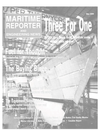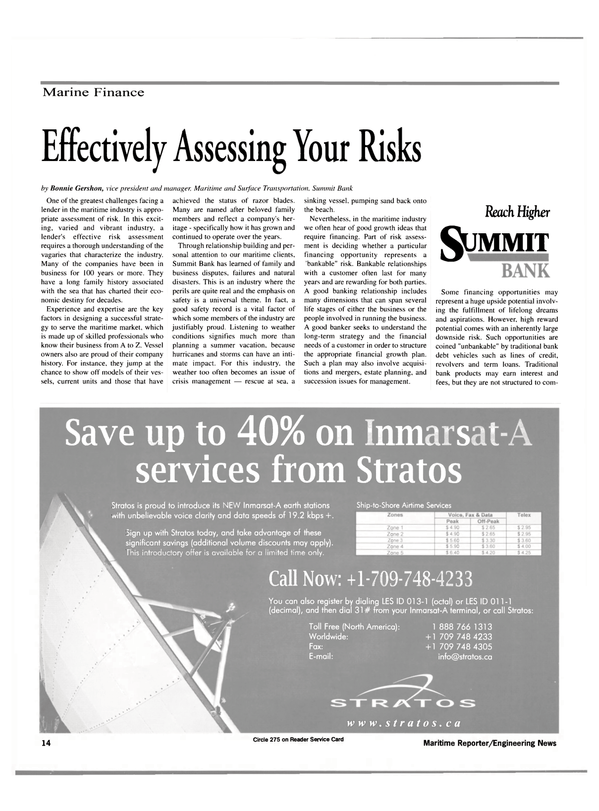
Effectively Assessing Your Risks
One of the greatest challenges facing a lender in the maritime industry is appropriate assessment of risk. In this exciting, varied and vibrant industry, a lender's effective risk assessment requires a thorough understanding of the vagaries that characterize the industry.
Many of the companies have been in business for 100 years or more. They have a long family history associated with the sea that has charted their economic destiny for decades.
Experience and expertise are the key factors in designing a successful strategy to serve the maritime market, which is made up of skilled professionals who know their business from A to Z. Vessel owners also are proud of their company history. For instance, they jump at the chance to show off models of their vessels, current units and those that have achieved the status of razor blades.
Many are named after beloved family members and reflect a company's heritage - specifically how it has grown and continued to operate over the years.
Through relationship building and personal attention to our maritime clients, Summit Bank has learned of family and business disputes, failures and natural disasters. This is an industry where the perils are quite real and the emphasis on safety is a universal theme. In fact, a good safety record is a vital factor of which some members of the industry are justifiably proud. Listening to weather conditions signifies much more than planning a summer vacation, because hurricanes and storms can have an intimate impact. For this industry, the weather too often becomes an issue of crisis management — rescue at sea, a sinking vessel, pumping sand back onto the beach.
Nevertheless, in the maritime industry we often hear of good growth ideas that require financing. Part of risk assessment is deciding whether a particular financing opportunity represents a "bankable" risk. Bankable relationships with a customer often last for many years and are rewarding for both parties.
A good banking relationship includes many dimensions that can span several life stages of either the business or the people involved in running the business.
A good banker seeks to understand the long-term strategy and the financial needs of a customer in order to structure the appropriate financial growth plan.
Such a plan may also involve acquisitions and mergers, estate planning, and succession issues for management.
Read Effectively Assessing Your Risks in Pdf, Flash or Html5 edition of May 2000 Maritime Reporter
Other stories from May 2000 issue
Content
- E-Utopia? page: 6
- Offshore Climbing Higher In Oslo page: 7
- Resilient Dutch Network page: 8
- New Runners From U.K. And Japanese Stables page: 10
- FGH Finalizes $40M Contracts page: 12
- Effectively Assessing Your Risks page: 14
- Reach Higher Summit Bank page: 14
- Coflexip Stena Awarded $58 Million Contract page: 16
- Congressional Maritime Legislative Initiatives In 2000 page: 20
- Spaarneborg Premieres As First Of Stora Enso's New Series page: 23
- MacGregor Outfits Advanced KHI-Built RoRo page: 26
- Eastern Builds Research Vessel For U of M page: 27
- Kvichak Supplies Patrol Vessel page: 29
- Trimaran Demonstrator Progressing At VT page: 32
- Alstom, USN Team For Integrated Solution page: 33
- MDI: Shipyard Production Expertise page: 34
- FR. Fassmer & Co.: Keeping It In The Family page: 35
- Wet Welding Provides More Than Quick Fix page: 36
- A New Wave of Customer-Driven Offerings: The SAGA Process page: 38
- Cost-Saving Coating Approved page: 40
- Kurz Joins Hvide As CEO page: 41
- Efficient Bunker Buyers "Need to Know" page: 42
- Online Fuel Supplier Fueled By Support page: 44
- Dylon Lubricant Develops Heavy Duty Grease page: 45
- Greek Ferries: The New Business Model page: 47
- Icy Wasteland Or Shipping Utopia? page: 55
- Specialties Cornerstone of Canadian Market page: 56
- Irving Shipbuilding Appoints New President page: 58
- Autoship, PAI Join Forces page: 58
- MV Paul J. Martin Christened At Port Weller page: 59
- Construction Contract Awarded For New Z-Drive Tug page: 59
- Fleet Technology Completes Option Study page: 60


